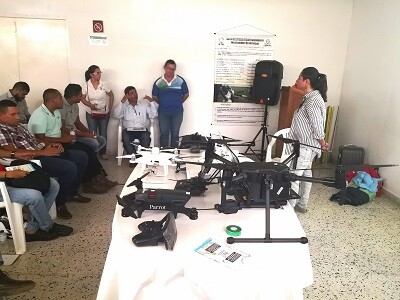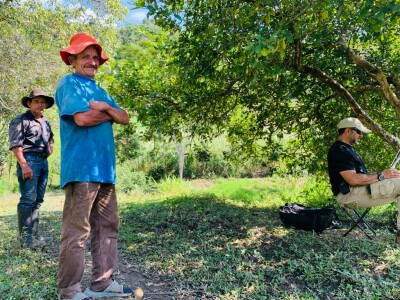One of the bright spots of the uncrewed aviation industry is without a doubt precision agriculture, and for good reason. For millennia, agriculture has been the realm of traditions and the passing of the baton from father to son and practices that are ingrained for generations, until a new technology comes along and revolutionizes the field (no pun intended).
 Only 100 years ago, most fields in the world were plowed with animal-drawn vehicles. Today, the general availability of GPS has transformed agriculture in a sophisticated series of workflows where just a few people can handle thousands of acres by utilizing complex machinery and precision methodologies.
Only 100 years ago, most fields in the world were plowed with animal-drawn vehicles. Today, the general availability of GPS has transformed agriculture in a sophisticated series of workflows where just a few people can handle thousands of acres by utilizing complex machinery and precision methodologies.
Now, the uncrewed aviation industry is ready to disrupt the field once again by adding an aerial component to almost every aspect of the farming routine. From sowing to monitoring to spraying to harvesting, drones can have a real impact on the optimization of processes and the saving of valuable resources such as water, fertilizers, and pesticides.
Drones are uniquely designed for these kinds of flights, and most of the problems that plague other sub-industries such as package delivery and infrastructure inspections do not apply to agriculture. Farming normally happens in dedicated areas and on land that is private and, most of the time, isolated from urban sectors. Agricultural drones fly low and therefore do not constitute a threat to general aviation. And all flights are conducted with permission from the owner of the land, and that takes care of the privacy issue.
The problem is that traditions are hard to break and introducing uncrewed aviation to farmers has been a little bit of a problem for companies that are trying to promote a better way to do things.
One company in Colombia, Energy Handmade, has been trying to introduce drones to the agricultural industry in that country for years. We had an exclusive conversation with Natalia Machado, CEO of Energy Handmade, in which she made clear that it has not been an easy road.
“Imagine the picture, a young woman with a drone trying to convince a farmer in a remote mountain of Colombia that he has been doing things wrong for decades!” Machado said with a laugh. “That approach quickly backfired, and we knew that we had to find a new way to get closer to the farmers without criticizing their current processes, it had to be a softer pitch, not a direct hit.”
A lot of farming in Colombia happens in slopes, at the bottom of huge mountains and in isolated areas where roads are almost never paved and the danger of violence is ever present, so Machado and her team had to navigate obstacles at every turn.
“We developed a workflow in which we mapped the land and then flew with different sensors to create a complete picture of the health of the plants, drainage issues and any other factor that would emerge as a result of the different flights,” Machado said. “But this complete analysis was too detailed and perhaps too scientific to be understood or appreciated by a farmer, so we had to find an intermediary, an interlocutor that would act on our behalf and we found it!”
 Small farming communities in Colombia are grouped in Cooperatives (Gremios), and these formal associations meet regularly and have agricultural engineers that work for them, advice on best practices and help with specific issues such as pests, infestations, drought, and selection of crops.
Small farming communities in Colombia are grouped in Cooperatives (Gremios), and these formal associations meet regularly and have agricultural engineers that work for them, advice on best practices and help with specific issues such as pests, infestations, drought, and selection of crops.
“We decided to go directly to the agro-engineer and convince him or her that our solution was the best approach to improve efficiencies and save money,” Machado said. “It didn’t take long for these professionals to realize how valuable our technology and our approach was. Initially, they selected a specific field, and we volunteered to do the entire work for free to introduce our technology to that specific cooperative. The engineer then presented the results to the farmers, digested and in their language and as a group, not one by one, and the results were fantastic. It was more of a business-to-business sale than a sale to the end customer, and it worked. It also addressed another important issue affecting farmers in Colombia—the fact that young people are leaving the farm in favor of urban life. Now, with the drones, some of these youngsters are staying and are excited to be at the forefront of a nascent industry.”
As with any other business, generating revenue was a challenge, and Machado and her team quickly discovered that spraying the crops was a quick and easy way to create income and gain credibility with the farmers, so they have been focused on this side of the business while the other, more technical approach takes off.
“We have also gone into the incredibly lucrative field of Carbon Credits (CC), by helping forestry companies exchange their CCs using ‘Carbonlytics’ a tool that we have developed in partnership with Sier-Inteia,” Machado said. “We are hopeful that this is just the beginning and now we are preparing our specific sales pitch for farmers in the distinct crops of avocados, African oil Palms and citrus, in order to expand into other geographical areas of the country. We are excited about the future.”
There is no doubt that uncrewed aviation has a solid future in this specific market, where isolation, rugged terrain, and an immense need to be more efficient combine to create fertile ground for new approaches to a very old human activity.




.png.small.400x400.png)










Comments